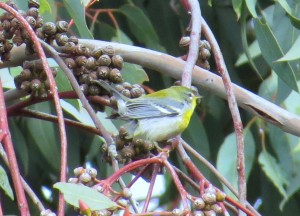
When Harold Reeve moved to Modesto in 1983, one of the first things he decided to do was keep a list of all the bird species he saw in Stanislaus County.
“County birding is the coming thing,” he told a friend. “I want us to have a good list.”
To Reeve, “good” means several things, but it especially means “accurate” and “thorough.” Like many birders, Reeve is more than a little data-obsessive. On most field trips he keeps meticulous written records of every bird he sees and the number of each species.
As a biology major and high school science teacher, he’s particularly concerned with reliable observations. For birders in general, and for hard core birders like Reeve in particular, the quest for reliability means providing accurate detail for any sightings of rare or unusual birds. Before digital photography, most detail for such sightings was in the form of written records. Today, in addition to written records, accompanying photographs are prized as proof the unexpected rarity really was where the observer said it was.
Over the thirty-some years he’s been listing birds in Stanislaus County, Reeve has found more than his share of rare birds. Back in 1985, he found a very rare Brown Thrasher at Tuolumne River Regional Park. And in 1997, he found what local experts believe is the most unlikely sighting ever in Stanislaus County: an ultra-rare White-eyed Vireo.
Along the way, Reeve has found many other first county records. Records are distinguished from sightings by the afore-mentioned photographic and written documentation. Reeve is renowned among birders for his exceptionally thorough written descriptions. These days, like most serious birders, he usually carries a digital camera for the “record” shot that confirms the written detail.
One of the more memorable of Reeve’s first county records showed up in 2008 while he was doing a “Green Year.” That year he kept track of birds he saw while running and carrying his binoculars in one hand. Sometimes he ran as far as ten or twelve miles. His total for the year was 175 species.
On one occasion he ran to the Ceres Sewage Ponds and saw an interesting bird through the fence. He was pretty sure he had a new bird for the Stanislaus County list, but he needed his telescope to be certain. Once he had fetched his telescope, Reeve was able to thoroughly document Stanislaus County’s first “record” Ruff, a kind of shorebird.
The in-joke for birders? A female Ruff is known as a “Reeve.”
Last Friday, Reeve got word of a sighting of a Northern Parula in a Eucalyptus tree near the old Basso Bridge in eastern Stanislaus County. It was only the second confirmed Stanislaus County record of this rare eastern warbler. The county’s first recorded Northern Parula made a brief appearance two years ago near Orange Blossom Road and was not seen again.
As soon as he got off work, Reeve raced out to the parking lot from which several observers had seen the Parula. Though he stayed out until dark, he didn’t find the bird. Most people would have been discouraged, but Harold Reeve does not discourage easily.
Saturday morning, Reeve was at the Parula location before dawn, using what little daylight he had until he had to return home for unavoidable obligations. Again, he could not find the Northern Parula.
Saturday afternoon, as soon as he had fulfilled his pre-commitments, Reeve was back on the chase, and the third time proved the charm. He and his wife Sharon were able to find the tiny but colorful bird and were treated to superb views.
The Central Valley Bird Club considers birders who’ve recorded 300 species in the entire Central Valley worthy of special recognition. The Northern Parula was Harold Reeve’s 300th species for Stanislaus County—a remarkable achievement, especially considering there are only 316 species on the entire Stanislaus County bird list.
As far as Reeve is concerned, the remaining sixteen birds represent yet another challenge. And then, of course, there are all the new birds to come.

“All the new birds to come”–wow. Mr. Reeve’s passion is inspiring. Bird life here in northern Modesto is rich. Having just moved here, I am amazed at the variety birds that visit. We regularly have hawks nesting in our trees, an owl hooting outside our bedroom at night, and my new favorite–a black phoebe who swoops the pool for insects. When farmers were spraying pesticides into the surrounding orchards recently, I wondered about the birds. I was out walking with my dog and noticed the newly posted signs warning against entering the orchards, but who loves trees more than birds? So much is here to love–birds, breezes, gardens. I wondered why we neighbors aren’t warned ahead of time, but even more, how the spraying affects the wildlife.